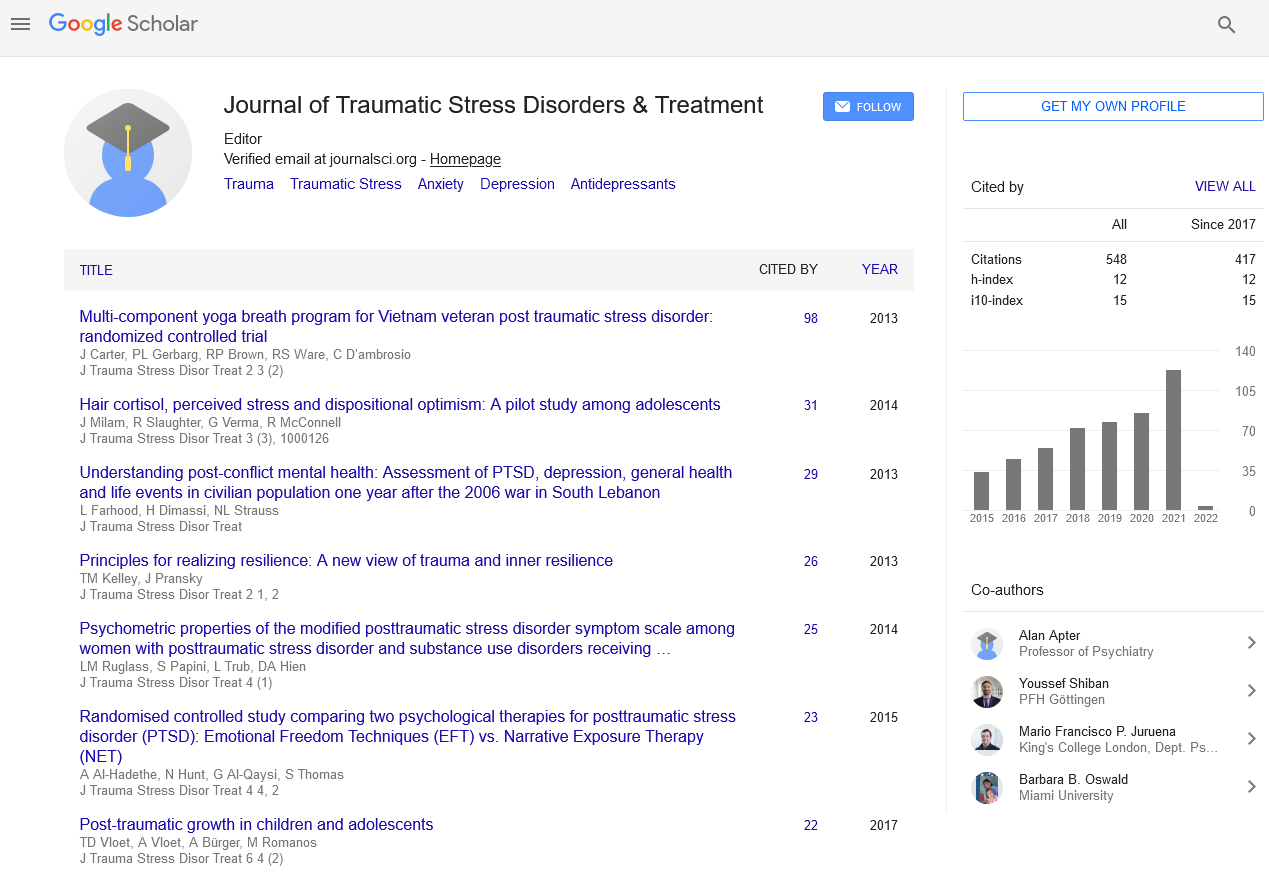Editorial, J Trauma Stress Disor Treat Vol: 1 Issue: 1
Traumatic Stress among Homeless Young Adults: Challenges and Treatment Issues
| Sanna J. Thompson* |
| University of Texas, USA |
| Corresponding author : Sanna J. Thompson University of Texas, USA E-mail: sannathompson@utexas.edu |
| Received: June 14, 2012 Accepted: June 15, 2012 Published: June 17, 2012 |
| Citation: Thompson SJ (2012) Traumatic Stress among Homeless Young Adults: Challenges and Treatment Issues. J Trauma Stress Disor Treat 1:1. doi:10.4172/2324-8947.1000e102 |
Abstract
Traumatic Stress among Homeless Young Adults: Challenges and Treatment Issues
Homeless emerging adults are one of this nation’s most underserved populations and are particularly vulnerable to the detrimental effects of trauma exposure, including developing PTSD. These young people typically reside in unstable and often abusive situations marked by violence and danger. They survive on the street through engaging in high risk behaviors, such as dumpsterdiving for food, panhandling/begging for money, and selling drugs or sex for money or shelter. These conditions result in a significant risk for serious health and mental health problems, including malnutrition, sexually transmitted diseases, depressive symptoms, posttraumatic stress, drug overdose and increased potential for selfharm and suicidal ideation.
| Homeless emerging adults are one of this nation’s most underserved populations and are particularly vulnerable to the detrimental effects of trauma exposure, including developing PTSD [1]. These young people typically reside in unstable and often abusive situations marked by violence and danger [2]. They survive on the street through engaging in high risk behaviors, such as dumpsterdiving for food, panhandling/begging for money, and selling drugs or sex for money or shelter [3]. These conditions result in a significant risk for serious health and mental health problems, including malnutrition, sexually transmitted diseases, depressive symptoms, posttraumatic stress, drug overdose and increased potential for selfharm and suicidal ideation [4]. The longer they remain on the streets, the more likely they have to experience victimization, violence, and various traumatizing experiences with debilitating consequences [5], such as emotional dysfunction and posttraumatic stress disorders [6,7]. Research suggests that 18-31% of these young people meet diagnostic criteria for PTSD [1] and lifetime prevalence rates for PTSD among homeless young adult females is 45% and 24% for males [8]. | |
| Homeless young adults present a unique challenge to service providers due to their continued involvement in activities that may result in ongoing trauma experiences. These young people are extremely unlikely to seek conventional mental health services due to mistrust of adult service providers [6]; thus, less conventional methods are needed to build rapport and develop trust before implementing formal treatment strategies aimed at ameliorating trauma symptoms [9]. While efforts are further complicated by the mobility and transience of homeless young people, service providers must work to overcome homeless young adults’ distrust, anger, and perception that adults are uncaring and unwilling to help [10]. | |
| The initial goal of treatment for PTSD is the restoration of some degree of safety and control over traumatic circumstances [11]; however, for homeless young adults their basic needs must be addressed before other therapeutic interventions can be introduced [12,13]. The ideal situation for providing care to these young people would be to immediately transition them into stable housing where a physically safe environment could be established and direct trauma work begin. This strategy is often not feasible or even desired by this population; thus, the use of current evidence-based treatments for PTSD, such as cognitive behavioral therapy (CBT), among homeless young adults remaining involved in the highly transient and dangerous street culture must be considered with caution. CBT consists of regular therapeutic sessions over relatively long periods of time after trauma has ended [14,15]. These requirements are not practical for homeless individuals who continue living in traumatizing environments. | |
| for PTSD, such as cognitive behavioral therapy (CBT), among homeless young adults remaining involved in the highly transient and dangerous street culture must be considered with caution. CBT consists of regular therapeutic sessions over relatively long periods of time after trauma has ended [14,15]. These requirements are not practical for homeless individuals who continue living in traumatizing environments. | |
References |
|
|

